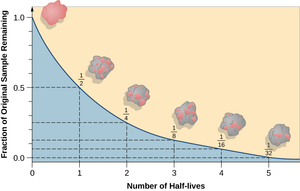Key Stage 4
Meaning
A half life is the time it takes for half of the unstable isotopes in a radioactive sample to decay.
About Half Life
- Every isotope has a unique half life.
- The half life of an isotope depends on how stable the isotope is.
- The half life of an isotope can be determined by measuring the emission of ionising radiation. The time it takes for the count rate of ionising radiation to halve, is the same as its half life.
| This diagram shows the number of Fermium-252 atoms halves each day, so the half life is 1 day. |
- The half life of an isotope can be found from plotting a graph of the amount or isotope or the count rate against the time. The half life is the time these take to halve from their initial value.
- The count rate of a sample of unstable isotope can be predicted given its initial count rate, its half life and the time it has been given.
Finding Half Life and Count Rate
| Time /s | 0 | 10 | 20 | 30 | 40 | 50 | 60 | 70 | 80 |
| Count rate /Bq | 1000 | 707 | 500 | 353 | 250 | 176 | 125 | 88 | 62 |
The half life of of this sample of radioactive isotope can be found by halving the initial count rate.
1000/2 = 500Bq
The isotope took 20 seconds to half in count rate so the half life is 20 seconds.
The count rate at 90 seconds can be predicted. Since the half life is 20 seconds the count rate 20 seconds earlier can be halved. At 70 seconds the count rate was 88Bq. Therefore at 90 seconds the count rate would be:
88/2 = 44Bq
The count rate at 10 seconds before the sample was first tested can also be predicted. Since the half life is 20 seconds the count rate 20 seconds later can be doubled. At 10 seconds the count rate was 707Bq. Therefore at -10 seconds the count rate would have been:
707x2= 1414Bq
| Time /min | 0 | 1 | 2 | 3 | 4 | 5 | 6 | 7 | 8 |
| Count rate /Bq | 5000 | 3968 | 3150 | 2500 | 1984 | 1575 | 1250 | 992 | 788 |

